SEO and content together can catapult your website into the top ranking positions, but only if the content is high quality and well optimized.
To produce good, SEO-friendly content, you’ll need to provide your users with relevant information that’s engaging, unique, and compelling. This is the case for any content you produce, whether it's a blog post, podcast, ebook, whitepaper, or any other form.
Researching Ideas and Target Keywords
Preparation is key to creating high-quality, optimized content. Your content should provide answers to the questions users typically search for. Researching what your content will focus on, deciding your target keyphrase, and determining what will be included within your content is as important as creating the content itself.
As a starting point, we'll pick one primary keyphrase (and additional semantic keyphrases) to include. The Keyword Magic tool can provide you with useful keyword data that help you determine the best keywords to include in your content.

As an example, we have chosen “sunflower” as a target term to begin our research:

As you can see, users have searched for the term sunflower 135,000 times on average each month just within the UK. However, we don’t want to focus the content solely on “sunflowers,” as the term is far too generic. We need to drill down deeper to decide what specific subject to focus on.
By clicking on the questions tab, we can identify questions users are frequently searching for when asking questions around sunflowers:
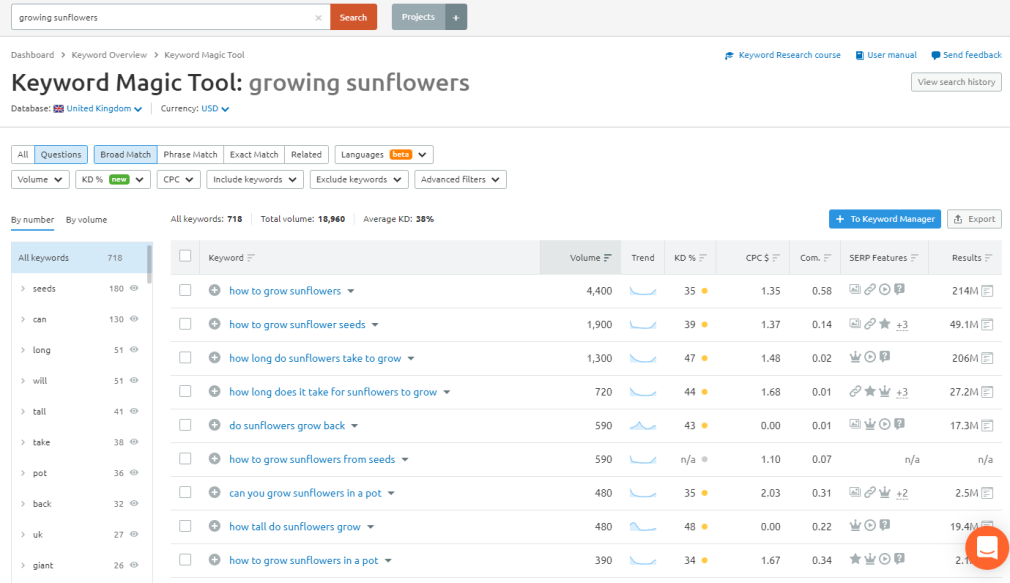
Identifying these questions helps us structure our content and determine possible subheadings throughout our content. ‘How to grow sunflowers’ generates a monthly search volume of 4,400 and provides the perfect basis for us to focus our content on.
Deciding on the searcher’s intent comes into play here. A user can have different motivations, desired outcomes, or intents when reading any content. There are 4 main types of user intent:
Informational intent Navigational intent Transactional intent Commercial/investigating intent“How to grow sunflowers” is an example of informational intent. By generating this content, you’re creating a clear solution to a query and addressing any potential pain points.
You’ll need to consider the user’s intent to decide where your content fits into the marketing funnel. As a content creator, you need to determine what your target user’s intent might be, then amend your content in order to meet this intent.
After Choosing Your Target Keyword
The SEO Content Template is another tool that content writers can utilize to craft SEO-friendly high-quality content once a primary target term has been decided. After you enter your keyword or group of keywords, a template will be generated.
The template provides you with a recommended content length, a readability score, semantically related keywords to include, potential backlink targets, and indicates if your competitors are using the target keywords you’ve entered.
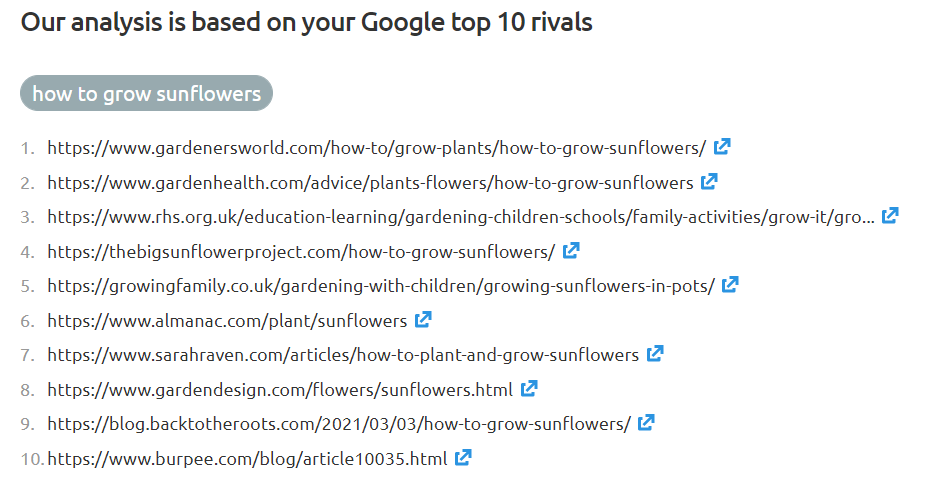
The top competing result lets us know what content we’re up against in order to create content that can surpass the existing ranking pages. Reading your competitors' content can also generate ideas you can incorporate in your copy and makes you aware of the type of content that’s already available.
We now also have some semantic phrases we can include in our content to help ensure search accuracy. Search engines will usually analyze the content’s text in search of elements that add depth to the content. It’s important your text contains words that are associated with your topic; the SEO content template will be able to generate this for you.
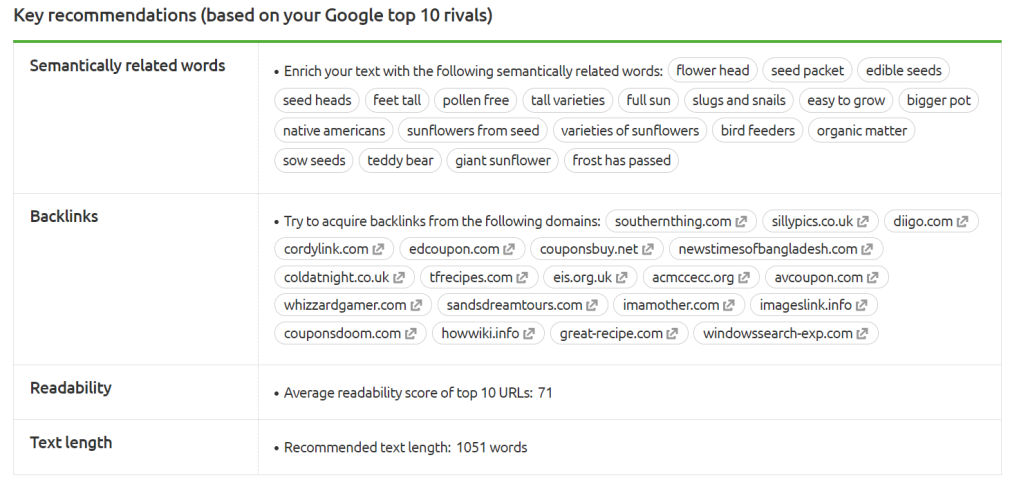
We should now have a range of semantic phrases and SEO guidance to help our content outrank any existing results.
Topic Research
Our Topic Research tool allows you to generate topic ideas around your target keyword or keyphrase. Enter the focus keyword of your content and select generate ‘get content ideas’ for a list of subtopics, including:
Headlines Questions Related SearchesThere are 4 ways you can view your results: cards, explorer, overview and mindmap. These can be sorted by volume, difficulty, or topic efficiency.
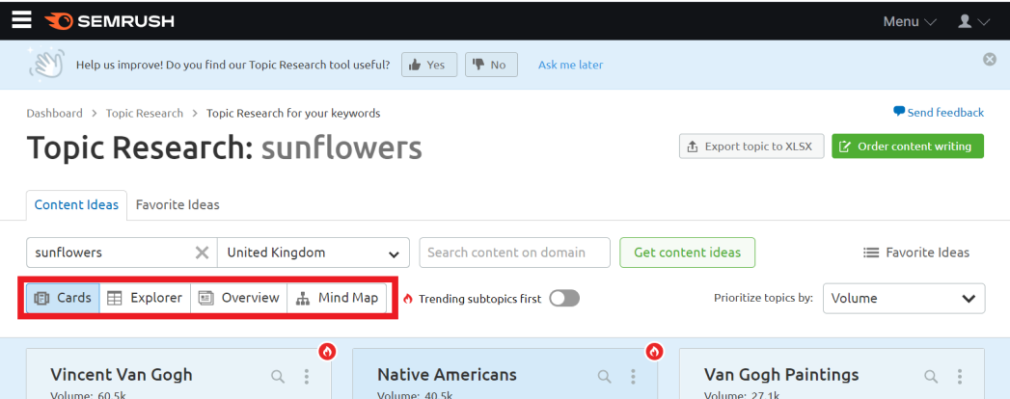
Here we are able to narrow down our research even further and focus on a home gardening angle.
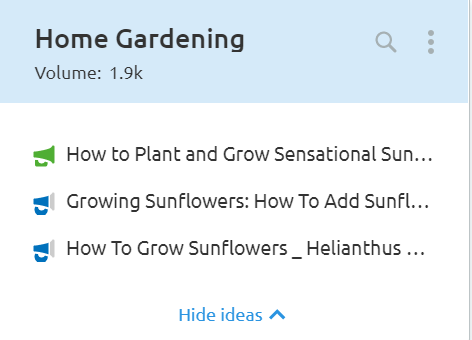
Each card includes a range of relevant ranking headlines and questions:
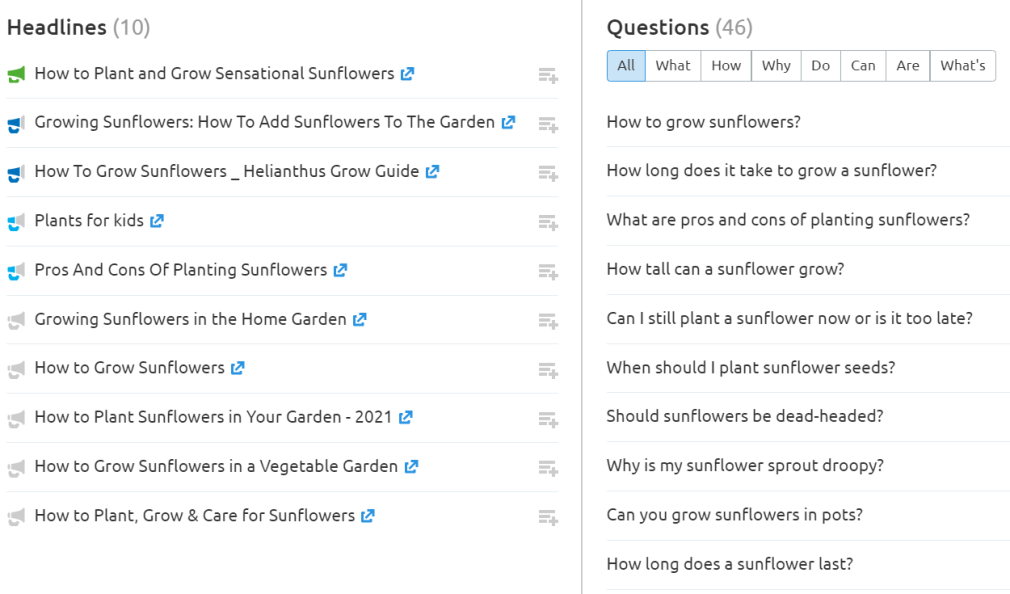
If you’re looking for further ideas, you can view all the searches related to your subtopic at the bottom of the topic card. Click on any of these related searches in order to start any new research for that term.
Types of Content To Consider
Now we know our target terms, what semantic phrases to include and what topics / sub-headings to incorporate, we can begin thinking about crafting our content.
This is when you really need to keep your target audience in mind. Generally, if a piece of content is going to benefit someone, they’re going to be much more interested in engaging with and reading it. This includes whether it’s answering a question or providing them with some really useful information.
Checklists, how-tos, and “top” lists are all great topics to write about. We’ve listed some ideas below:
How-tos Checklists Lists Reviews Video content Case studies Infographics Interviews Guest Posts SurveysChoosing what is best for you will become clear when analyzing what type of content is already available and what sort of content will engage with your target market.
Structuring Your Content
Now we know what type of content we’re drafting and also what we’re going to include in it, we need to think about how we structure our content.
Here are a few recommendations below to help you structure your content into manageable, digestible chunks we think your readers will love.
Create a compelling headline: Your headline will appear in the SERPs, so it needs to be catchy and enticing. ‘How’ or ‘why’ are good words to include as they help address a user’s questions. Carefully reflect on what is in the post; don’t be tempted to title your post with clickbait. Attract the reader’s attention with a good intro: If you’ve managed to get an audience to click on the title, great work. However, you also need a compelling introduction that will intrigue users to continue to read on. Your first sentence is the most important and should provide clues as to what is coming next. Break Paragraphs Up - In order to make sure your content is structured well, break it up using paragraphs. Users want to digest bite-sized chunks in order to understand the content more easily. Include Subheadings: A good subheading allow a user to find a section of content they need more efficiently. They allow search engine crawl bots to more efficiently crawl your pages, so these are great opportunities to include phrases. Language: Make sure you keep the language you use is simple. Shorter sentences are easier to read and are more digestible. Keep them short and sweet. Your users will appreciate it. Spelling & Grammar: For a really good piece of quality content, your spelling and grammar need to be on point. After all, if you include basic spelling mistakes, your readers likely won’t consider you as a trustworthy authority. Brand Tone: Writing for your business must fit into your company’s tone and ethos.Checking Your Content
Finally, once you have created your piece of text content, you can check its quality, optimization, tone of voice, and originality with the SEO Writing Assistant.
Once you’ve added your content to the quick checker, it returns an overall score out of 10. The helpful diagram will also provide some analysis on the area that might need the most work.
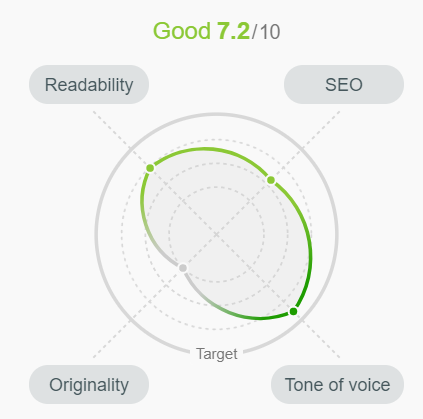
These recommendations guide you to improve your content while focusing on:
SEO: Enhances your text with semantic keyword recommendations, makes sure your content doesn’t overuse any terms, analyses alt attributes and ensures your links are not broken.
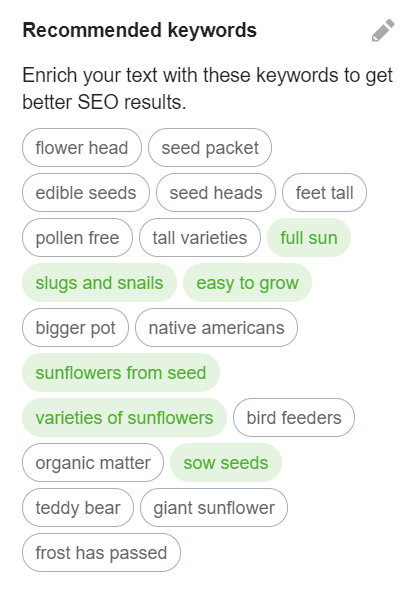
The tool has the ability to highlight any phrases you’ve successfully used within your content and any that might be worth adding, enabling you to optimize your content even further:
Readability: This feature tracks your text’s readability, provides recommendations on word count, optimizes your title, and makes sure your text is clear and understandable.
This tool also has the ability to provide you with a readability score, so you can understand how readable your piece of content is. If your reader finds your content easy to read, the more likely it is they will continue to read on.

It will list tips and tricks that can help your content become more fluid and flow more easily by providing advice like the above.
Originality: This feature checks the percentage of plagiarized sentences in your content and identifies original sources of content from across the internet.
If your content is copied this will be highlighted here:
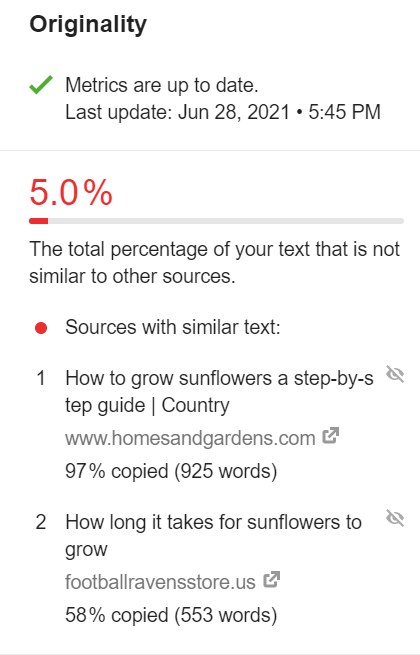
When it comes to quality content, originality is key and those that plagiarised other pieces of content will struggle to gain any organic search visibility.
Tone of voice consistency: This feature finds the most informal and most formal sentences that stand out within the overall copy to make your text consistent.
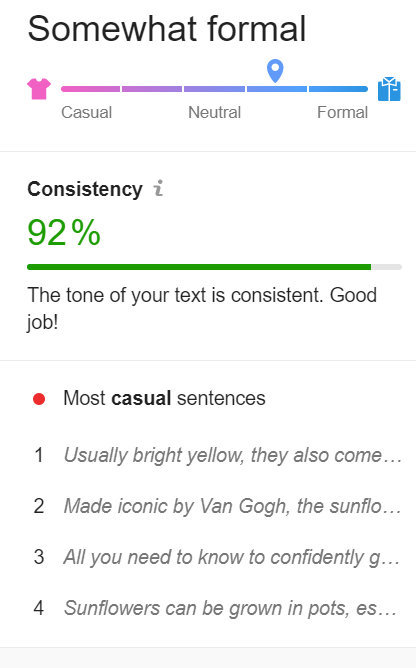
This can help your content’s tone of voice is on-brand and consistent with your other content.
Once Your Content Is Live
Now your high-quality content can go live on your site, it’s important to track its performance.
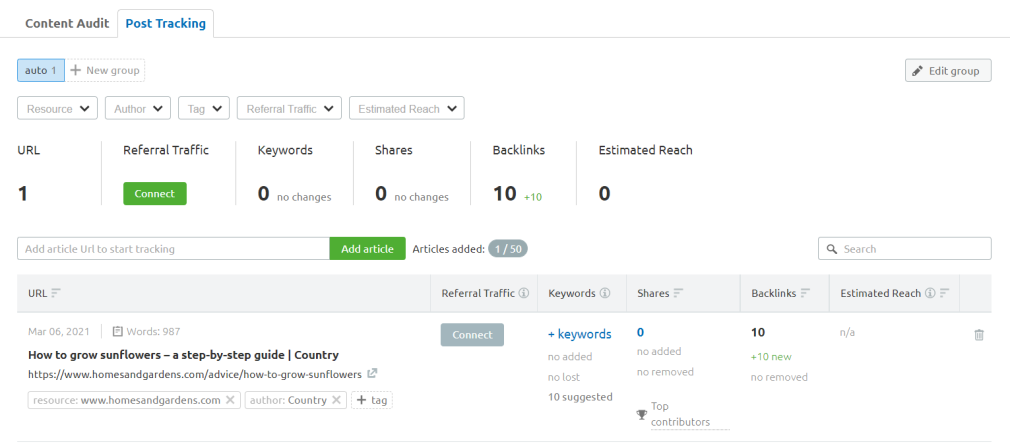
The post-tracking feature of the Content Analyzer tool can help you analyze the success of your content by providing key metrics for up to 50 articles (on the free plan). Just enter in a URL and it will return:
The number of social shares The number of pages that have linked to the content The number of people who may have viewed the article The number of people that came to the post based on data from Google AnalyticsAll information is detailed in easy-to-follow graphs that help you determine your content’s performance.
Now you have everything you need to be able to craft the highest quality piece of content.
Innovative SEO services
SEO is a patience game; no secret there. We`ll work with you to develop a Search strategy focused on producing increased traffic rankings in as early as 3-months.
A proven Allinclusive. SEO services for measuring, executing, and optimizing for Search Engine success. We say what we do and do what we say.
Our company as Semrush Agency Partner has designed a search engine optimization service that is both ethical and result-driven. We use the latest tools, strategies, and trends to help you move up in the search engines for the right keywords to get noticed by the right audience.
Today, you can schedule a Discovery call with us about your company needs.
Source:





